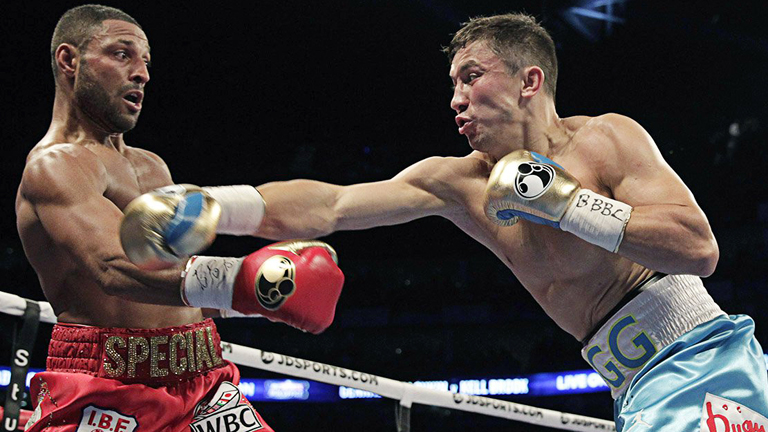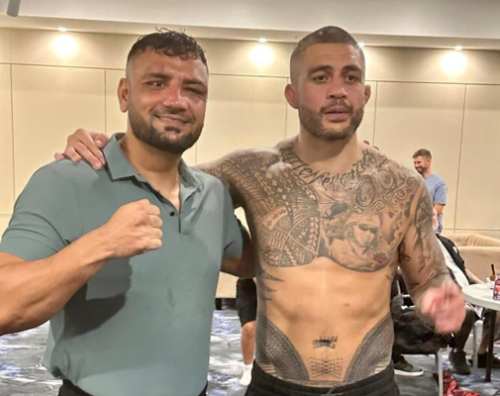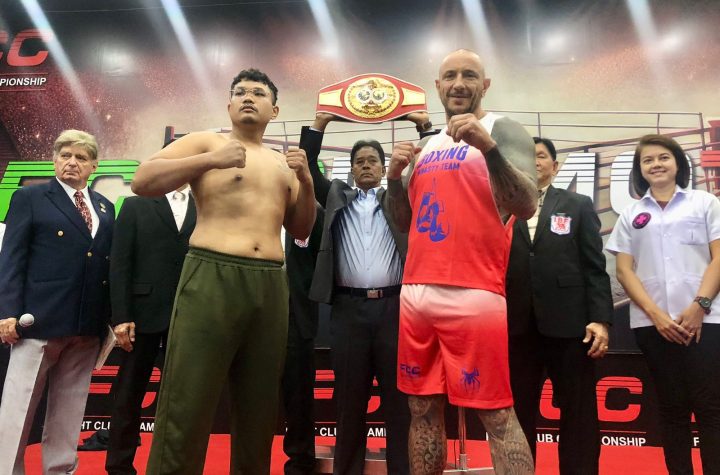
‘You have to make Gennady Golovkin go crazy,’ explains Roberto Duran

Lawrence Lustig/Matchroom
ALL-TIME great Roberto Duran ended a UK speaking tour as a guest of honour at former British/Commonwealth/European super-middleweight champion Henry Wharton’s York gym. The living legend, accompanied and translated by his son, Robin, spent around an hour talking about his long and largely glorious career.
Duran, who informed the gathering of around 200 fans that he turned pro in 1968 at the age of just 13, having lied about his age, made other revelations, too. Duran said his payday for his pro debut was a mere £3 dollars, but that he believed from a young age that he was destined to be a world champion.
“The main thing for a fighter is to fight for a world championship, it’s the biggest goal in life,” Duran, sat in mid-ring with his son, said.
“So when they told me I was getting that opportunity, I became very excited and I began training straight away, because I needed to become champion, I had to become a champion.
“It’s very hard [fighting and taking on the champion] but when you are the challenger, you are hungrier than the champion, you are coming up and you are super-motivated to win. When you are the champion, it is harder, you feel as though you don’t need to train. This is what happened to me when I fought Tommy Hearns; I was too arrogant and I didn’t think I had to bother training. But that [the Hearns fight] wasn’t the first time I was knocked – my wife knocked me out before that! (laughs). But Ken Buchanan from Scotland, he was a very strong fighter, a great fighter. That win (TKO13 in 1972) remains my most cherished memory today, because that was my first world title win. I freely admit I hit him low in the early rounds, but at the end of the fight, no. He simply could not go on any further.
“The press conference before the fight, Buchanan arrived late and when he got there he made himself a sandwich, they were showing a fight of mine on the big screen, and Ken didn’t look at it once. I asked him, ‘Why aren’t you watching my fight?’ And he said that he didn’t need to, that I was too slow for him. Right then, I made sure I trained harder than ever before in my life. I was so ready for that fight and I made sure I was as fast, as strong and as relentless as I could possibly be.”
Duran then spoke about his fights with Sugar Ray Leonard fight; the infamous “No Mas” rematch in particular. Though much has been written about this fight and the shocking way in which Duran threw up his hands and quit in New Orleans, Duran had a few additional tales regarding the fight:
“My manager called me, I was just at home watching TV, and he said he had got me a fight with the new superstar from America. He told me I’d be fighting the best America had to offer, a fighter that was called The King of New York. I wanted to be The King of New York, and after I beat him [Leonard] I was! The fans went crazy after that win, I was partying for a long, long time after that win (laughs).
“The second fight, I was up to around 196 pounds and my manager said I had to go back to Panama right now, that the second fight was signed. I said, ‘Are you crazy!’ I knew I couldn’t fight again so soon. But I had a month to lose all that weight. I starved myself, I pushed myself so hard. In sparring, I felt each punch from my sparring partners, they felt like rocks. I was ill and I felt bad. I crawled to the weighing scale. I then had a cup of coffee and some water and I felt sick. Later I saw members from Leonard’s team loosening the ropes in the ring, in the corners. In the fight, when I had Leonard in the corner, he was able to get away from my punches. There were a lot of shady things in that fight.
“Also, I never said the words, ‘No Mas.’ That was made up by American commentator Howard Cosell. He didn’t like me very much, because I never gave him many interviews. So he made that up. I waved my arms in the air, yes, but I never said anything. How could Cosell have heard me anyway, from all the way across the ring where he was? I had really bad stomach cramps and I thought I would lose the fight, then get the third fight and make sure I was in top shape to kick his ass. But he never gave me that third fight (until years later, in 1989).”
Duran was asked to name the toughest fight of his career:
“Iran Barkley, definitely. I was told by everyone not to take that fight. In my country of Panama, they said that I should have my license taken away if I tried to take that fight. When your own country is against you it makes it very hard. Also, I would have liked a second fight with [Marvin] Hagler. In fact, Hagler promised me one but he never gave me it. I watched his fights from after our fight (in 1983, a razor-thin 15 round decision win for Hagler), against [Juan Domingo] Roldan and Mustafa [Hamsho] and I knew I could beat him. I had him figured out, how he would switch from orthodox to southpaw. He preferred fighting as a southpaw and in a rematch I would have been ready for him.”
Duran was asked what he thinks of Gennady Golovkin and who he would most like to have fought from today’s era:
“It is a different time of course and today there are less great fighters but there is more money. Golovkin, you cannot square up with him [Duran got up and showed a few moves on how he would approach GGG]. You must give him angles, as he will come right at you, trying to kill you! You must make him go crazy [with movement and by spinning him, not letting him get set] and then you must box him. The one fighter from today I would most like to fight is Mayweather. All four of us, The Four Kings, we all beat better fighters than Mayweather. He has learnt a lot from me, his defensive moves. I would beat him up!”
Duran on who the best fighters in boxing history are:
“Me! Myself, I am the best. But after me, my top-four is: Rocky Marciano, Joe Louis, Muhammad Ali, Sugar Ray Robinson.”
Finally, Duran, who fought in five separate decades and retired with an amazing 103-16(70) record in 2001, spoke about the recent film of his life, “Hands of Stone:”
“It’s a good film, with accuracy. It goes up to my fight with Davey Moore (in 1983) and this is where it ends, so I hope for a sequel; a second film that will focus on the 1980s and all those big fights.”






More News
IBF Asia Heavyweight Title Fight: Bisutti vs. Nattapong
Liu Gang, Brico Santig Join Forces
Highland’s Double Impact: August 18 at Lumpinee